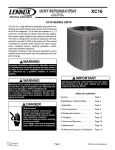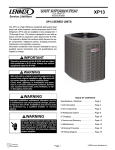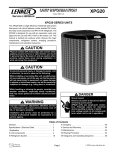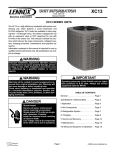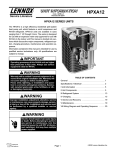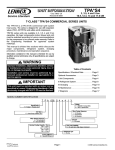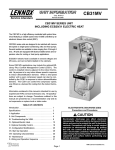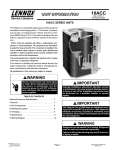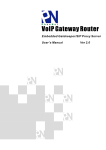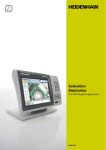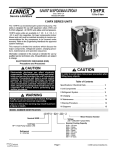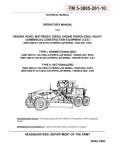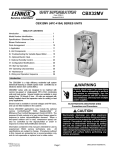Download XP16 Series - HvacPartsShop.com
Transcript
Service Literature Corp. 0626−L5 Revised 06−2008 XP16 XP16 SERIES UNITS The XP16 is a high efficiency residential split−system heat pump unit, which features a scroll compressor and R−410A refrigerant. XP16 units are available in 2, 3, 4 and 5 tons. tons. XP16 units are rated for 230 volts only. Applications where supply voltage is less requires a hard start kit. The series is designed for use with an indoor unit with an expansion valve approved for R−410A. This manual is divided into sections which discuss the major components, refrigerant system, charging procedure, maintenance and operation sequence. Information contained in this manual is intended for use by qualified service technicians only. All specifications are subject to change. IMPORTANT Operating pressures of this R−410A unit are higher than pressures in R−22 units. Always use service equipment rated for R−410A. WARNING Warranty will be voided if covered equipment is removed from original installation site. Warranty will not cover damage or defect resulting from: Flood, wind, lightning, or installation and operation in a corrosive atmosphere (chlorine, fluorine, salt, recycled waste water, urine, fertilizers, or other damaging chemicals). TABLE OF CONTENTS WARNING Improper installation, adjustment, alteration, service or maintenance can cause property damage, personal injury or loss of life. Installation and service must be performed by a qualified installer or service agency. Specifications / Electrical . . . . . . . . . . . . . Page 2 I Unit Information . . . . . . . . . . . . . . . . . . . . Page 3 II Unit Components . . . . . . . . . . . . . . . . . . Page 4 III Refrigerant System . . . . . . . . . . . . . . . . Page 16 WARNING IV Charging . . . . . . . . . . . . . . . . . . . . . . . . . Page 18 Electric shock hazard. Can cause injury or death. Before attempting to perform any service or maintenance, turn the electrical power to unit OFF at disconnect switch(es). Unit may have multiple power supplies. Page 1 V Service and Recovery . . . . . . . . . . . . . . Page 21 VI Maintenance . . . . . . . . . . . . . . . . . . . . . . Page 22 VII Wiring Diagram . . . . . . . . . . . . . . . . . . . Page 23 ©2006 Lennox Industries Inc. SPECIFICATIONS Model No. Nominal Tonnage Liquid line (o.d.) − in. Connections ( (sweat) t) Vapor line (o.d.) − in. 1 R−410A charge furnished Refrigerant Net face area − sq. ft. Outer coil Outdoor C il Coil Inner coil Tube diameter − in. No. of rows Fins per inch Diameter − in. Outdoor F Fan No. of blades Motor hp Cfm Rpm Watts Shipping Data − lbs. 1 pkg. General D t Data XP16−024 2 3/8 3/4 9 lbs. 9 oz. 13.22 12.65 5/16 2 22 18 3 1/10 2215 1040 145 219 XP16−036 3 3/8 7/8 12 lbs. 8 oz. 18.67 18.0 5/16 2 22 22 4 1/6 3150 844 215 265 XP16−048 4 3/8 7/8 15 lbs. 7 oz. 24.5 23.64 5/16 2 22 22 4 1/4 3980 836 305 309 XP16−060 5 3/8 1−1/8 13 lbs. 8 oz. 24.93 24.14 5/16 2 22 26 3 1/3 4380 850 280 345 4 208/230V−1ph 4 208/230V−1ph 4 208/230V−1ph 4 208/230V−1ph 20 14.0 10.25 52 0.98 1.1 2 35 22.0 16.67 82 0.99 1.1 2.1 45 28.2 21.15 96 0.99 1.7 3.1 60 33.9 25.87 118 0.99 1.8 2.9 ELECTRICAL DATA Line voltage data − 60hz 2 Maximum overcurrent protection (amps) 3 Minimum circuit ampacity Rated load amps Compressor p Locked rotor amps Power factor Full load amps Outdoor Coil F Motor Fan M t Locked rotor amps OPTIONAL ACCESSORIES − must be ordered extra Compressor p Hard Start Kit − Required q i applications in li ti with ith lless th than 230V 10J42 81J69 45F08 93G35 50A93 40K58 68M04 76F53 56A87 Compressor Low Ambient Cut−Off 3/8 in. tubing Freezestat 5/8 in. tubing Indoor Blower Relay Low Ambient Kit Monitor Kit − Service Light Thermostat Outdoor Thermostat Mounting Box 31461 Kit SignatureStatt Home Comfort Control 81M28 L15−41−20 L15−41−40 Refrigerant L15−41−30 L15−41−50 Line Sets L15−65−30 Time Delay Relay L15−65−40 L15−65−50 Field Fabricate 58M81 NOTE − Extremes of operating range are plus 10% and minus 5% of line voltage. 1 Refrigerant charge sufficient for 15 ft. length of refrigerant lines. 2 HACR type breaker or fuse. 3 Refer to National or Canadian Electrical Code manual to determine wire, fuse and disconnect size requirements. 4 Hard start kit is required in applications where the supply voltage is less than 230V. Page 2 I − UNIT INFORMATION All major components (indoor blower and coil) must be matched according to Lennox recommendations for the compressor to be covered under warranty. Refer to the Engineering Handbook for approved system matchups. A misapplied system will cause erratic operation and can result in early compressor failure. ELECTROSTATIC DISCHARGE (ESD) Precautions and Procedures Slightly rotate and guide the lip of top tab inward (figure 1, Details A and C); then upward into the top slot of the hinge corner post. Rotate panel to vertical to fully engage all tabs. Holding the panel’s hinged side firmly in place, close the right−hand side of the panel, aligning the screw holes. When panel is correctly positioned and aligned, insert the screws and tighten. Removing/Installing Louvered Panels IMPORTANT! Do not allow panels to hang on unit by top tab. Tab is for alignment and not designed to support weight of panel. CAUTION Panel shown slightly rotated to allow top tab to exit (or enter) top slot for removing (or installing) panel. Electrostatic discharge can affect electronic components. Take precautions during unit installation and service to protect the unit’s electronic controls. Precautions will help to avoid control exposure to electrostatic discharge by putting the unit, the control and the technician at the same electrostatic potential. Neutralize electrostatic charge by touching hand and all tools on an unpainted unit surface before performing any service procedure. SCREW HOLES LIP Detail A Detail B CAUTION To prevent personal injury, or damage to panels, unit or structure, be sure to observe the following: While installing or servicing this unit, carefully stow all removed panels out of the way, so that the panels will not cause injury to personnel, nor cause damage to objects or structures nearby, nor will the panels be subjected to damage (e.g., being bent or scratched). While handling or stowing the panels, consider any weather conditions, especially windy conditions, that may cause panels to be blown around and battered. Remove the louvered panels as follows: 1. Remove 2 screws, allowing the panel to swing open slightly (see figure 1). 2. Hold the panel firmly throughout this procedure. Rotate bottom corner of panel away from hinge corner post until lower 3 tabs clear the slots (see figure 1, Detail B). 3. Move panel down until lip of upper tab clears the top slot in corner post (see figure 1, Detail A). Position and Install PanelPosition the panel almost parallel with the unit (figure 1, Detail D) with the screw side" as close to the unit as possible. Then, in a continuous motion: Page 3 ROTATE IN THIS DIRECTION; THEN DOWN TO REMOVE PANEL Detail C MAINTAIN MINIMUM PANEL ANGLE (AS CLOSE TO PARALLEL WITH THE UNIT AS POSSIBLE) WHILE INSTALLING PANEL. HOLD DOOR FIRMLY TO THE HINGED ANGLE MAY BE TOO SIDE TO MAINTAIN EXTREME FULLY−ENGAGED TABS PREFERRED ANGLE FOR INSTALLATION Detail D FIGURE 1 II − UNIT COMPONENTS 24V THERMOSTAT TERMINAL STRIP Unit components are illustrated in figure 2. XP16 UNIT COMPONENTS OUTDOOR FAN COMPRESSOR Y1 O Y2 R L C W1 FIGURE 4 CONTROL BOX 1 − Compressor Contactor K1 REVERSING VALVE EXPANSION VALVE HIGH PRESSURE SWITCH FILTER DRIER The compressor is energized by a contactor located in the control box. See figure 3. Single−pole contactors are used in all XP16 series units. K1 is energized through the control board by the indoor thermostat terminal Y1 (24V) when thermostat demand is present. DANGER LOW PRESSURE SWITCH Electric Shock Hazard. May cause injury or death. Line voltage is present at all components when unit is not in operation on units with single pole contactors. Disconnect all remote electrical power supplies before opening unit panel. Unit may have multiple power supplies. VAPOR LINE SERVICE LIQUID LINE VALVE SERVICE VALVE FIGURE 2 A − Control Box (Figure 3) XP16 units are not equipped with a 24V transformer. All 24 VAC controls are powered by the indoor unit. Refer to wiring diagram. UNIT CONTROL BOX DUAL CAPACITOR (C12) COMPRESSOR CONTACTOR (K1) DEFROST CONTROL (A108) GROUNDING LUG FIGURE 3 Electrical openings are provided under the control box cover. Field thermostat wiring is made to a 24V terminal strip located on the defrost control board located in the control box. See figure 4. 2 − Dual Capacitor C12 The compressor and fan in XP16 series units use permanent split capacitor motors. The capacitor is located inside the unit control box (see figure 3). A single dual" capacitor (C12) is used for both the fan motor and the compressor (see unit wiring diagram). The fan side and the compressor side of the capacitor have different MFD ratings. See side of capacitor for ratings. 3 − Start Kit (option) The start kit consists of a potential relay K31 and start capacitor C7. The potential relay controls the operation of the starting circuit. The relay is normally closed when contactor K1 is de−energized. When K1 is energized, the compressor immediately begins start up. K31 remains closed during compressor start up and and start capacitor C7 remains in the circuit. When compressor reaches approximately 75% of its speed, K31 is energized. When K31 energizes, the contacts open and start capacitor C7 is taken out of the circuit. Page 4 4 − Defrost Control The demand defrost controller measures differential temperatures to detect when the system is performing poorly because of ice build−up on the outdoor coil. The controller self−calibrates" when the defrost system starts and after each system defrost cycle. The defrost control board components are shown in figure 5. Defrost Control Board Defrost Board Pressure Switch Settings Note − Component Locations Vary by Board Manufacturer. TEST PINS High Pressure (auto reset) − trip at 590 psig; reset at 418 psig. Low Pressure (auto reset) − trip at 25 psig; reset at 40 psig. LOW AMBIENT THERMOSTAT PINS DEFROST TERMINATION PIN SETTINGS SENSOR PLUG IN (COIL, AMBIENT, & DISCHARGESENSORS) during the defrost cycle and 90 seconds after the termination of defrost when the average ambient sensor temperature is below 15° F (−9°C) for 90 seconds following the start up of the compressor during "test" mode High Pressure Switch (HI−PS)When the high pressure switch trips, the defrost board will cycle off the compressor, and the strike counter in the board will count one strike. 5−Strike Lockout Feature The internal control logic of the board counts the pressure switch trips only while the Y1 (Input) line is active. If a pressure switch opens and closes four times during a Y1 (Input), the control logic will reset the pressure switch trip counter to zero at the end of the Y1 (Input). If the pressure switch opens for a fifth time during the current Y1 (Input), the control will enter a lockout condition. The 5−strike pressure switch lockout condition can be reset by cycling OFF the 24−volt power to the control board or by shorting the TEST pins between 1 and 2 seconds. All timer functions (run times) will also be reset. If a pressure switch opens while the Y1 Out line is engaged, a 5−minute short cycle will occur after the switch closes. DIAGNOSTIC LEDS DELAY PINS REVERSING VALVE 24V TERMINAL STRIP CONNECTIONS PRESSURE SWITCH CIRCUIT CONNECTIONS Defrost System Sensors FIGURE 5 The control monitors ambient temperature, outdoor coil temperature, and total run time to determine when a defrost cycle is required. The coil temperature probe is designed with a spring clip to allow mounting to the outside coil tubing. The location of the coil sensor is important for proper defrost operation. NOTE − The demand defrost board accurately measures the performance of the system as frost accumulates on the outdoor coil. This typically will translate into longer running time between defrost cycles as more frost accumulates on the outdoor coil before the board initiates defrost cycles. Diagnostic LEDs The state (Off, On, Flashing) of two LEDs on the defrost board (DS1 [Red] and DS2 [Green]) indicate diagnostics conditions that are described in table 2. Defrost Board Pressure Switch Connections The unit’s automatic reset pressure switches (LO PS − S87 and HI PS − S4) are factory−wired into the defrost board on the LO−PS and HI−PS terminals, respectively. Low Pressure Switch (LO−PS)When the low pressure switch trips, the defrost board will cycle off the compressor, and the strike counter in the board will count one strike. The low pressure switch is ignored under the following conditions: Page 5 Sensors connect to the defrost board through a field-replaceable harness assembly that plugs into the board. Through the sensors, the board detects outdoor ambient, coil, and discharge temperature fault conditions. As the detected temperature changes, the resistance across the sensor changes. Sensor resistance values can be checked by ohming across pins shown in table 1. The graph in figure 6 shows sensor temperature to resistance range. NOTE − When checking the ohms across a sensor, be aware that a sensor showing a resistance value that is not within the range shown in table 1, may be performing as designed. However, if a shorted or open circuit is detected, then the sensor may be faulty and the sensor harness will need to be replaced. TABLE 1 Sensor Temperature / Resistance Range Temperature Range °F (°C) Resistance values range (ohms) Pins/Wire Color Outdoor −35 (−37) to 120 (48) 280,000 to 3750 3&4 (Black) Coil −35 (−37) to 120 (48) 280,000 to 3750 5&6 (Brown) Discharge (if applicable) 24 (−4) to 350 (176) 41,000 to 103 1&2 (Yellow) Sensor Note: Sensor resistance increases as sensed temperature decreases. Ambient and Coil Sensor 90 TEMPERATURE (ºF) 80 Discharge Sensor 300 5750 280 7450 260 9275 70 11775 TEMPERATURE (ºF) 100 15425 60 19975 50 26200 40 34375 30 46275 20 62700 10 240 220 200 180 160 200 225 250 275 325 375 425 500 600 700 825 1000 1175 1400 1700 2025 2500 140 3000 3750 120 85300 0 4650 5825 100 10000 30000 50000 RESISTANCE (OHMS) 70000 90000 1000 2000 3000 4000 RESISTANCE (OHMS) 5000 6000 FIGURE 6 Sensor Locations DETAIL B" XP16−024 COIL SENSOR 7 tubes up from bottom (7−1/2") XP16−036 DEFROST BOARD DEFROST SENSOR HARNESS COIL SENSOR 17 tubes up from bottom (17−1/2") XP16−060 DETAIL A" COIL SENSOR 12 tubes up from bottom (11−1/2") AMBIENT SENSOR XP16−048 DISCHARGE LINE SENSOR IN ONE OF TWO LOCATIONS DETAIL C" COIL SENSOR − APPLY GREASE BETWEEN RETURN BEND AND SENSOR FIGURE 7 Page 6 COIL SENSOR 13 tubes up from bottom (12−1/2") CLIP COIL TEMPERATURE SENSOR FROM THE DEFROST BOARD ON THE RETURN BEND SHOWN. Ambient SensorThe ambient sensor (shown in detail A, figure 7) considers outdoor temperatures below −35°F (−37°C) or above 120°F (48°C) as a problem. If the ambient sensor is detected as being open, shorted or out of the temperature range of the sensor, the board will not perform demand defrost operation. The board will revert to time/temperature defrost operation and will display the appropriate fault code. Heating and cooling operation will be allowed in this fault condition. Coil SensorThe coil temperature sensor (shown in detail B, figure 7) considers outdoor temperatures below −35°F (−37°C) or above 120°F (48°C) as a problem. If the coil temperature sensor is detected as being open, shorted or out of the temperature range of the sensor, the board will not perform demand or time/temperature defrost operation and will display the appropriate fault code. Heating and cooling operation will be allowed in this fault condition. Discharge Line SensorIf the discharge line temperature (shown in figure 7) exceeds a temperature of 285°F (140°C) during compressor operation, the board will de−energize the compressor contactor output (and the defrost output, if active). The compressor will remain off until the discharge temperature has dropped below 225°F (107°C) and the 5-minute anti−short cycle delay has been satisfied. This sensor has two fault and lockout codes: 4. If the board recognizes five high discharge line temperature faults during a single (Y1) compressor demand, it reverts to a lockout mode and displays the appropriate code. This code detects shorted sensor or high discharge temperatures. (Code on board is Discharge Line Temperature Fault and Lockout"). 5. If the board recognizes five temperature sensor range faults during a single (Y1) compressor demand, it reverts to a lockout mode and displays the appropriate code. The board detects open sensor or out-of-temperature sensor range. This fault is detected by allowing the unit to run for 90 seconds before checking sensor resistance. If the sensor resistance is not within range after 90 seconds, the board will count one fault. After 5 faults, the board will lockout. (Code on board is Discharge Sensor Fault and Lockout"). Page 7 The discharge line sensor, which covers a range of 150°F (65°C) to 350°F (176°C), is designed to mount on a ½" refrigerant discharge line. NOTE − Within a single room thermostat demand, if 5−strikes occur, the board will lockout the unit. Defrost board 24 volt power R" must be cycled OFF" or the TEST" pins on board must be shorted between 1 to 2 seconds to reset the board. Second−Stage OperationIf the board receives a call for second−stage compressor operation Y2" in heating or cooling mode and the first-stage compressor output is active, the second-stage compressor solenoid output will be energized. If first-stage compressor output is active in heating mode and the outdoor ambient temperature is below the selected compressor lock−in temperature, the second-stage compressor solenoid output will be energized without the Y2" room thermostat input. If the jumper is not connected to one of the temperature selection pins on P3 (40, 45, 50, 55°F), the default lock−in temperature of 40°F (4.5°C) will be used. The board de−energizes the second-stage compressor solenoid output immediately when the Y2" signal is removed or the outdoor ambient temperature is 5°F above the selected compressor lock−in temperature, or the first-stage compressor output is de−energized for any reason. Defrost Temperature Termination Shunt (Jumper) PinsThe defrost board selections are: 50, 70, 90, and 100°F (10, 21, 32 and 38°C). The shunt termination pin is factory set at 50°F (10°C). If the temperature shunt is not installed, the default termination temperature is 90°F (32°C). Delay Mode The defrost board has a field−selectable function to reduce occasional sounds that may occur while the unit is cycling in and out of the defrost mode. When a jumper is installed on the DELAY pins, the compressor will be cycled off for 30 seconds going in and out of the defrost mode. Units are shipped with jumper installed on DELAY pins. NOTE − The 30 second off cycle is NOT functional when jumpering the TEST pins. Operational Description The defrost control board has three basic operational modes: normal, calibration, and defrost. Normal ModeThe demand defrost board monitors the O line, to determine the system operating mode (heat/cool), outdoor ambient temperature, coil temperature (outdoor coil) and compressor run time to determine when a defrost cycle is required. Calibration ModeThe board is considered uncalibrated when power is applied to the board, after cool mode operation, or if the coil temperature exceeds the termination temperature when it is in heat mode. Calibration of the board occurs after a defrost cycle to ensure that there is no ice on the coil. During calibration, the temperature of both the coil and the ambient sensor are measured to establish the temperature differential which is required to allow a defrost cycle. Defrost ModeThe following paragraphs provide a detailed description of the defrost system operation. Detailed Defrost System Operation Defrost CyclesThe demand defrost control board initiates a defrost cycle based on either frost detection or time. Frost DetectionIf the compressor runs longer than 34 minutes and the actual difference between the clear coil and frosted coil temperatures exceeds the maximum difference allowed by the control, a defrost cycle will be initiated. TimeIf 6 hours of heating mode compressor run time has elapsed since the last defrost cycle while the coil temperature remains below 35°F (2°C), the demand defrost control will initiate a defrost cycle. ActuationWhen the reversing valve is de−energized, the Y1 circuit is energized, and the coil temperature is below 35°F (2°C), the board logs the compressor run time. If the board is not calibrated, a defrost cycle will be initiated after 34 minutes of heating mode compressor run time. The control will attempt to self−calibrate after this (and all other) defrost cycle(s). Calibration success depends on stable system temperatures during the 20−minute calibration period. If the board fails to calibrate, another defrost cycle will be initiated after 45 minutes (90 minutes on −1 to −4 boards) of heating mode compressor run time. Once the defrost board is calibrated, it initiates a demand defrost cycle when the difference between the clear coil and frosted coil temperatures exceeds the maximum difference allowed by the control OR after 6 hours of heating mode compressor run time has been logged since the last defrost cycle. NOTE − If ambient or coil fault is detected, the board will not execute the TEST" mode. TerminationThe defrost cycle ends when the coil temperature exceeds the termination temperature or after 14 minutes of defrost operation. If the defrost is terminated by the 14−minute timer, another defrost cycle will be initiated after 34 minutes of run time. Test ModeWhen Y1 is energized and 24V power is being applied to the board, a test cycle can be initiated by placing the termination temperature jumper across the Test" pins for 2 to 5 seconds. If the jumper remains across the Test" pins longer than 5 seconds, the control will ignore the test pins and revert to normal operation. The jumper will initiate one cycle per test. Enter the TEST" mode by placing a shunt (jumper) across the TEST" pins on the board after power−up. (The TEST" pins are ignored and the test function is locked out if the shunt is applied on the TEST" pins before power−up). Board timings are reduced, the low−pressure switch and loss of charge detection fault is ignored and the board will clear any active lockout condition. Each test pin shorting will result in one test event. For each TEST" the shunt (jumper) must be removed for at least 1 second and reapplied. Refer to flow chart (figure 8) for TEST" operation. Note: The Y1 input must be active (ON) and the O" room thermostat terminal into board must be inactive. Defrost Board Diagnostics See table 2 to determine defrost board operational conditions and to diagnose cause and solution to problems. Page 8 Test Mode Y1 Active (0" line inactive) Short test pins for longer than 1 second but less than 2.0 seconds Clear any short cycle lockout and 5 strike fault lockout function, if applicable. No other functions will be executed and unit will continue in the mode it was operating. Short test pins for more than 2.0 seconds Clear any short cycle lockout and 5 strike fault lockout function, if applicable. If in COOLING Mode No further test mode operation will be executed until the test short is removed and reapplied. If in HEATING Mode The controller will check for ambient and coil faults (open or shorted). If a fault exists, the unit will remain in Heat Mode and no further test mode operation will be executed until the test short is removed and re applied. If no fault exists, the unit will go into Defrost mode. Test pin short REMAINS in place for more than 5 seconds The unit will return to Heat mode uncalibrated with defrost timer set for 34 minutes. No further test mode operation will be executed until the test short is removed and re applied. FIGURE 8 Page 9 If in DEFROST Mode The unit will terminate defrost and enter Heat Mode uncalibrated with defrost timer set for 34 minute test. No further test mode operation will be executed until the test short is removed and reapplied. Test pins short REMOVED before a maximum of 5 seconds The unit will remain in Defrost mode until termination on time or temperature TABLE 2 Defrost Control Board Diagnostic LEDs DS2 DS1 Green Red Condition/Code Possible Cause(s) Solution OFF Power problem No power (24V) to board terminals R & C or board failure. 1 Check control transformer power (24V). 2 If power is available to board and LED(s) OFF do not light, replace board. Simultaneous SLOW Flash Normal operation Unit operating normally or in standby mode. None required. Alternating SLOW Flash 5−minute anti−short cycle delay Initial power up, safety trip, end of room thermostat demand. None required (Jumper TEST pins to override) Simultaneous FAST Flash Ambient Sensor Problem Sensor being detected open or shorted or out of temperature range. Board will revert to time/temperature defrost operation. (System will still heat or cool). Alternating FAST Flash Coil Sensor Problem Sensor being detected open or shorted or out of temperature range. Board will not perform demand or time/temperature defrost operation. (System will still heat or cool). ON Circuit Board Failure Indicates that board has internal component failure. Cycle 24 volt power to board. If code does not clear, replace board. ON FAULT & LOCKOUT CODES (Each fault adds 1 strike to that code’s counter; 5 strikes per code = LOCKOUT) OFF SLOW Flash Low Pressure Fault OFF ON Low Pressure LOCKOUT SLOW Flash OFF High Pressure Fault ON OFF High Pressure LOCKOUT SLOW Flash ON Discharge Line Temperature Fault FAST Flash ON Discharge Line Temperature LOCKOUT OFF Fast Flash Discharge Sensor Fault Fast Flash OFF Discharge Sensor LOCKOUT 1 Restricted air flow over indoor or outdoor coil. 2 Improper p p refrigerant g g in charge system. t 3 Improper metering device installed or incorrect operation of metering device. 4 Incorrect or improper sensor location or connection to sys system. 1 Remove any blockages or restrictions from coils and/or fans. Check indoor and outdoor p p current draws. fan motor for proper 2 Check charge using Ch k system t h i approach h & subb cooling temperatures. 3 Check system operating pressures and compare to unit charging charts. 4 Make sure all pressure switches and sensors have secure connections to system to prevent refrigerant leaks or errors in pressure and temperature measurements. This code detects shorted sensor or high discharge temperatures. If the discharge line temperature exceeds a temperature of 285ºF (140ºC) during compressor operation the board will de−energize the compressor contactor output (and the defrost eration, output if active). The compressor will remain off until the discharge temperature has dropped below 225ºF (107ºC). The board detects open sensor or out of temperature sensor range. This fault is detected by allowing the unit to run for 90 seconds before checking sensor resistance If the sensor resistance is not within range after 90 seconds ance. seconds, the board will count one fault. After 5 faults, the board will lockout. Page 10 B − Two−Stage Scroll Compressor (B1) CROSS−SECTION OF SCROLLS DISCHARGE DISCHARGE PRESSURE TWO−STAGE MODULATED SCROLL slider ring STATIONARY SCROLL SUCTION TIPS SEALED BY DISCHARGE PRESSURE solenoid actuator coil FIGURE 9 The scroll compressor design is simple, efficient and requires few moving parts. A cutaway diagram of the scroll compressor is shown in figure 1.The scrolls are located in the top of the compressor can and the motor is located just below. The oil level is immediately below the motor. The scroll is a simple compression concept centered around the unique spiral shape of the scroll and its inherent properties. Figure 10 shows the basic scroll form. Two identical scrolls are mated together forming concentric spiral shapes (figure 11). One scroll remains stationary, while the other is allowed to orbit" (figure 12). Note that the orbiting scroll does not rotate or turn but merely orbits" the stationary scroll. SCROLL FORM FIGURE 10 Page 11 ORBITING SCROLL FIGURE 11 The counterclockwise orbiting scroll draws gas into the outer crescent shaped gas pocket created by the two scrolls (figure 4 − 1). The centrifugal action of the orbiting scroll seals off the flanks of the scrolls (figure 4 − 2). As the orbiting motion continues, the gas is forced toward the center of the scroll and the gas pocket becomes compressed (figure 4 −3). When the compressed gas reaches the center, it is discharged vertically into a chamber and discharge port in the top of the compressor (figure9). The discharge pressure forcing down on the top scroll helps seal off the upper and lower edges (tips) of the scrolls (figure 11). During a single orbit, several pockets of gas are compressed simultaneously providing smooth continuous compression. The scroll compressor is tolerant to the effects of liquid return. If liquid enters the scrolls, the orbiting scroll is allowed to separate from the stationary scroll. The liquid is worked toward the center of the scroll and is discharged. Due to its efficiency, the scroll compressor is capable of drawing a much deeper vacuum than reciprocating compressors. Deep vacuum operation can cause internal fusite arcing resulting in damaged internal parts and will result in compressor failure. This type of damage can be detected and will result in denial of warranty claims. The scroll compressor can be used to pump down refrigerant as long as the pressure is not reduced below 7 psig. NOTE − During operation, the head of a scroll compressor may be hot since it is in constant contact with discharge gas. The scroll compressors in all XP16 model units are designed for use with R410A refrigerant and operation at high pressures. Compressors are shipped from the factory with 3MA (32MMMA) P.O.E. oil. See electrical section in this manual for compressor specifications. TWO−STAGE OPERATION The two−stage scroll compressor operates like any standard scroll compressor with the exception the two−stage compressor modulates between first stage (low capacity approximately 67%) and second stage (high capacity). Modulation occurs when gas is bypassed through bypass ports (figure 13 bypass ports open) in the first suction pocket. This bypassing of gas allows the compressor to operate on first stage (low capacity) if thermostat demand allows. Indoor thermostat setting will determine first or second stage operation. The compressor will operate on first−stage until demand is satisfied or the indoor temperature reaches the thermostat set point calling for second−stage. Second−stage (high capacity) is achieved by blocking the bypass ports (figure 13 bypass ports closed) with a slider ring. The slider ring begins in the open position and is controlled by a 24VDC internal solenoid. On a Y2 call the internal solenoid closes the slider ring, blocking the bypass ports and bringing the compressor to high capacity. Two− stage modulation can occur during a single thermostat demand as the motor runs continuously while the compressor modulates from first−stage to second− stage. HOW A SCROLL WORKS MOVEMENT OF ORBIT SUCTION SUCTION INTERMEDIATE PRESSURE GAS CRESCENT SHAPED GAS POCKET ORBITING SCROLL SUCTION POCKET 1 SUCTION 2 FLANKS SEALED BY STATIONARY SCROLL CENTRIFUGAL FORCE 3 SUCTION 4 HIGH PRESSURE GAS DISCHARGE POCKET FIGURE 12 TWO−STAGE MODULATION Bypass Ports Closed High Capacity FIGURE 13 Page 12 Bypass Ports Open Low Capacity INTERNAL SOLENOID (L34) Procedure The internal unloader solenoid controls the two−stage operation of the compressor by shifting a slide ring mechanism to open two by−pass ports in the first compression pocket of the scrolls in the compressor. The internal solenoid is activated by a 24 volt direct current solenoid coil. The coil power requires 20VAC. The internal wires from the solenoid in the compressor are routed to a 2 pin fusite connection on the side of the compressor shell. The external electrical connection is made to the compressor with a molded plug assembly. This plug contains a full wave rectifier that converts 24 volt AC into 24 volt DC power to power the unloader solenoid. Refer to unit diagram for internal circuitry view of plug. If it is suspect the unloader is not operating properly, check the following IMPORTANT 1. Turn main power "OFF" to outdoor unit. 2. Adjust room thermostat set point above (heating operation on heat pump) or below (cooling operation) the room temperature 5ºF. 3. Remove control access panel. Install refrigeration gauges on unit. Attach the amp meter to the common (black wire) wire of the compressor harness. Attach thermometer to discharge line as close as possible to the compressor. 4. Turn toggle switch "OFF" and install switch in series with Y2 wire from room thermostat. 5. Cycle main power "ON." 6. Allow pressures and temperatures to stabilize before taking any measured reading (may take up to 10 minutes). NOTE − Block outdoor coil to maintain a minimum of 375 psig during testing). 7. Record all of the readings for the Y1 demand on table 3. This performance check is ONLY valid on systems that have clean indoor and outdoor coils, proper airflow over coils, and correct system refrigerant charge. All components in the system must be functioning proper to correctly perform compressor modulation operational check. (Accurate measurements are critical to this test as indoor system loading and outdoor ambient can affect variations between low and high capacity readings). STEP 1 Confirm low to high capacity compressor operation Tools required Refrigeration gauge set Digital volt/amp meter Electronic temperature thermometer On-off toggle switch Page 13 8. Close switch to energize Y2 demand. 9. Allow pressures and temperatures to stabilize before taking any measured reading (this may take up to 10 minutes). 10. Record all of the readings of Y2 demand on table 3. NOTE − On new installations or installations that have shut down for an extended period of time, if the compressor does not cycle from low stage to high stage on the first attempt, it may be necessary to recycle the compressor back down to low stage and back up to high stage a few times in order to get the bypass seals to properly seat Compare Y1 readings with Y2 readings in table 3. Some readings should be higher, lower or the same. If the readings follow what table 3 specifies, the compressor is operating and shifting to high capacity as designed. If the readings do not follow what table 3 specifies, continue to step 2 to determine if problem is with external solenoid plug power. TABLE 3 Compressor Operation Unit Readings Y1 − 1st-Stage Expected Results Y2 − 2nd-Stage Compressor Voltage Amperage Same Higher Condenser Fan motor Amperage Same or Higher Temperature Ambient Outdoor Coil Discharge Air Same Higher in Cooling Lower in Heating Higher Same Lower in Cooling Higher in Heating Compressor Discharge Line Indoor Return Air Indoor Coil Discharge Air Pressures Suction (Vapor) Liquid Lower Higher STEP 2 Confirm DC voltage output on compressor solenoid plug rectifier plug leads apply 24vac A − Compressor solenoid plug WITH built in full wave− rectifier (LSOM I) that converts 24 volt AC into 24 volt DC power. See Table 1 for units equipped with the LSOM I. compressor fusite terminals 1. Shut power off to outdoor unit. solenoid fusite terminals meter compressor 2. Supply 24 volts AC control voltage to the wire ends of the full wave rectifier plug. Listen for a click" as the solenoid is energized. See figure 14. rectifier plug leads apply 24vac FIGURE 15 If the above checks verify that the solenoid plug is providing power to cycle into high capacity operation, continue to step 3 to determine if problem is with solenoid coil in compressor STEP 3 Confirm internal unloader solenoid has proper resistance solenoid fusite terminals compressor fusite terminals 1. Shut all power off to unit (main and low voltage) meter compressor FIGURE 14 3. Unplug the full wave rectifier plug from the fusite connection on the compressor. 4. Turn the low voltage power back onto the unit. Supply 24VAC to the wires of the full wave rectifier plug. Set volt meter to DC volts and measure the DC voltage at the female connector end of the full wave rectifier plug. The DC voltage reading should be 1.5 to 3 volts lower than the input voltage to the plug wire leads. (EX: Input voltage is 24VAC output voltage is 22VDC). See figure 15. 2. Unplug the molded plug from the compressor solenoid 2−pin fusite. 3. Using a volt meter set on the 200 ohm scale Replace the Compressor under these conditions: Bad Solenoid a. Measure the resistance at the 2−pin fusite. The resistance should be 32 to 60 ohms depending on compressor temperature. If no resist ancereplace compressor. b. Measure the resistance from each fusite pin to ground. There should not be continuity to ground. If solenoid coil is grounded, replace compressor. Good Solenoid a. Seals not shifting, replace compressor b. Slider ring not shifting, replace compressor. Page 14 C − Outdoor Fan Motor D − Reversing Valve L1 and Solenoid All units use single−phase PSC fan motors which require a run capacitor. In all units, the condenser fan is controlled by the compressor contactor. A refrigerant reversing valve with electromechanical solenoid is used to reverse refrigerant flow during unit operation. The reversing valve requires no maintenance. It is not repairable. If the reversing valve has failed, it must be replaced. ELECTRICAL DATA tables in this manual show specifications for condenser fans used in XP16’s. Access to the condenser fan motor on all units is gained by removing the four screws securing the fan assembly. See figure 16. The grill fan assembly can be removed from the cabinet as one piece. See figure 17. The condenser fan motor is removed from the fan guard by removing the four nuts found on top of the grill. See figure 17 if condenser fan motor replacement is necessary. DANGER E − Crankcase Heater (HR1) & Thermostat (S40) The compressor in the unit is equipped with a 70 watt, belly band type crankcase heater. HR1 prevents liquid from accumulating in the compressor. HR1 is controlled by a thermostat located on the liquid line. When liquid line temperature drops below 50° F the thermostat closes energizing HR1. The thermostat will open, de−energizing HR1 once liquid line temperature reaches 70° F . F − Drier Make sure all power is disconnected before beginning electrical service procedures. A filter drier designed for all XP16 model units is factory installed in the liquid line. The filter drier is designed to remove moisture and foreign matter, which can lead to compressor failure. Remove screws Moisture and / or Acid Check Because POE oils absorb moisture, the dryness of the system must be verified any time the refrigerant system is exposed to open air. A compressor oil sample must be taken to determine if excessive moisture has been introduced to the oil. Table 4 lists kits available from Lennox to check POE oils. If oil sample taken from a system that has been exposed to open air does not test in the dry color range, the filter drier MUST be replace. Remove screws IMPORTANT FIGURE 16 Replacement filter drier MUST be approved for R−410A refrigerant and POE application. Foreign Matter Check NUTS (4) It is recommended that a liquid line filter drier be replaced when the pressure drop across the filter drier is greater than 4 psig. To safeguard against moisture entering the system follow the steps in section IV − sub section B − "Evacuating the System" when replacing the drier. ALIGN FAN HUB FLUSH WITH END OF SHAFT FIGURE 17 TABLE 4 KIT CONTENTS TUBE SHELF LIFE 10N46 − Refrigerant Analysis Checkmate−RT700 10N45 − Acid Test Tubes Checkmate−RT750A (three pack) 2 − 3 years @ room temperature. 3+ years refrigerated 10N44 − Moisture Test Tubes Checkmate − RT751 Tubes (three pack) 6 − 12 months @ room temperature. 2 years refrigerated 74N40 − Easy Oil Test Tubes Checkmate − RT752C Tubes (three pack) 2 − 3 years @ room temperature. 3+ years refrigerated 74N39 − Acid Test Kit Sporian One Shot − TA−1 Page 15 An auto-reset, single-pole/single-throw low pressure switch is located in the suction line. This switch shuts off the compressor when suction pressure drops below the factory setting. The switch is closed during normal operating pressure conditions and is permanently adjusted to trip (open) at 25 + 5 psi. The switch automatically resets when suction line pressure rises above 40 + 5 psi. Under certain conditions the low pressure switch is ignored. See Pressure Switch Circuit in the Defrost Control description. G − High/Low Pressure Switch IMPORTANT Pressure switch settings for R−410A refrigerant will be significantly higher than units with R−22. An auto-reset, single-pole/single-throw high pressure switch is located in the liquid line. This switch shuts off the compressor when liquid line pressure rises above the factory setting. The switch is normally closed and is permanently adjusted to trip (open) at 590 + 10 psi. III − REFRIGERANT SYSTEM Refer to figure 18 for refrigerant flow. The reversing valve is energized during cooling demand and during defrost. XP16 COOLING CYCLE (SHOWING MANIFOLD GAUGE CONNECTIONS) OUTDOOR UNIT DISTRIBUTOR COIL SENSOR REVERSING VALVE EXPANSION/CHECK VALVE LOW PRESSURE HIGH PRESSURE BIFLOW FILTER / DRIER OUTDOOR COIL INTERNAL COMPRESSOR LIMIT INDOOR UNIT MUFFLER GAUGE MANIFOLD TO R−410A DRUM LIQUID LINE SERVICE PORT SUCTION SERVICE PORT VAPOR LINE VALVE COMPRESSOR EXPANSION/CHECK VALVE NOTE − ARROWS INDICATE DIRECTION OF REFRIGERANT FLOW. REFRIGERANT WILL FLOW IN OPPOSITE DIRECTION IN HEATING CYCLE FIGURE 18 Page 16 INDOOR COIL A − Plumbing To Close Service Valve: Field refrigerant piping consists of liquid and vapor lines from the outdoor unit (sweat connections). Use Lennox L15 (sweat) series line sets as shown in table 1. TABLE 1 1 − Remove the stem cap with an adjustable wrench. 2 − Use a service wrench with a hex−head extension to turn the stem clockwise to seat the valve. Tighten the stem firmly. NOTE − Use a 3/16" hex head extension for 3/8" line sizes or a 5/16" extension for large line sizes. 3 − Replace the stem cap. Tighten finger tight, then tighten an additional 1/6 turn. Unit Liquid Line Suction Line L15 Line Sets −024, 3/8 in. (10 mm) 3/4 in. (19 mm) L15−65 15 ft. − 50 ft. (4.6 m − 15 m) 7/8 in. (22 mm) L15−65 15 ft. − 50 ft. (4.6 m − 15 m) −036, −048 −060 3/8 in. (10 mm) 3/8 in. (10 mm) 1−1/8 in. (29 mm) Service Valve (Valve Closed) stem cap service port Field Fabricated insert hex wrench here to outdoor coil B − Service Valves service port cap IMPORTANT Only use Allen wrenches of sufficient hardness (50Rc − Rockwell Harness Scale min). Fully insert the wrench into the valve stem recess. Service valve stems are factory torqued (from 9 ft lbs for small valves, to 25 ft lbs for large valves) to prevent refrigerant loss during shipping and handling. Using an Allen wrench rated at less than 50Rc risks rounding or breaking off the wrench, or stripping the valve stem recess. to indoor coil Schrader valve open to line set when valve is closed (front seated) (valve front seated) insert hex wrench here Service valves (figures 19 and 20) and gauge ports are accessible from the outside of the unit. Use the service ports for leak testing, evacuating, charging and checking charge. Each valve is equipped with a service port which has a factory−installed Schrader valve. A service port cap protects the Schrader valve from contamination and serves as the primary leak seal. To Access Schrader Port: 1 − Remove service port cap with an adjustable wrench. 2 − Connect gauge to the service port. 3 − When testing is complete, replace service port cap. Tighten finger tight, then an additional 1/6 turn. To Open Service Valve: 1 − Remove the stem cap with an adjustable wrench. 2 − Use a service wrench with a hex−head extension to back the stem out counterclockwise as far as it will go. NOTE − Use a 3/16" hex head extension for 3/8" line sizes or a 5/16" extension for large line sizes. 3 − Replace the stem cap. Tighten finger tight, then tighten an additional 1/6 turn. Page 17 Service Valve (Valve Open) stem cap service port to outdoor coil service port cap to indoor coil Schrader valve FIGURE 19 Vapor Line Ball Valve – 4 & 5 Ton Only Vapor line service valves function the same way as the other valves, the difference is in the construction. If a valve has failed, you must replace it. A ball valve is illustrated in figure 20. The ball valve is equipped with a service port with a factory− installed Schrader valve. A service port cap protects the Schrader valve from contamination and assures a leak−free seal. Ball Valve (Valve Open) Use Adjustable Wrench To open: rotate Stem Clockwise 90°. To close: rotate Stem Counter-clockwise 90°. stem cap to outdoor coil stem ball (shown open) to indoor coil service port cap service port Schrader valve FIGURE 20 IV − CHARGING A − Leak Testing After the line set has been connected to the indoor and outdoor units, check the line set connections and indoor unit for leaks. WARNING Refrigerant can be harmful if it is inhaled. Refrigerant must be used and recovered responsibly. Failure to follow this warning may result in personal injury or death. WARNING Fire, Explosion and Personal Safety Hazard. Failure to follow this warning could result in damage, personal injury or death. Never use oxygen to pressurize or purge refrigeration lines. Oxygen, when exposed to a spark or open flame, can cause damage by fire and / or an explosion, that can result in personal injury or death. WARNING Danger of explosion! When using a high pressure gas such as dry nitrogen to pressurize a refrigerant or air conditioning system, use a regulator that can control the pressure down to 1 or 2 psig (6.9 to 13.8 kPa). Using an Electronic Leak Detector or Halide 1 − Connect a cylinder of R−410A to the center port of the manifold gauge set. 2 − With both manifold valves closed, open the valve on the R−410A cylinder (vapor only). 3 − Open the high pressure side of the manifold to allow the R−410A into the line set and indoor unit. Weigh in a trace amount of R−410A. [A trace amount is a maximum of 2 ounces (57 g) or 3 pounds (31 kPa) pressure.] Close the valve on the R−410A cylinder and the valve on the high pressure side of the manifold gauge set. Disconnect the R−410A cylinder. 4 − Connect a cylinder of nitrogen with a pressure regulating valve to the center port of the manifold gauge set. 5 − Connect the manifold gauge set high pressure hose to the vapor valve service port. (Normally, the high pressure hose is connected to the liquid line port; however, connecting it to the vapor port better protects the manifold gauge set from high pressure damage.) 6 − Adjust the nitrogen pressure to 150 psig (1034 kPa). Open the valve on the high side of the manifold gauge set which will pressurize line set and indoor unit. 7 − After a few minutes, open a refrigerant port to ensure the refrigerant you added is adequate to be detected. (Amounts of refrigerant will vary with line lengths.) Check all joints for leaks. Purge nitrogen and R−410A mixture. Correct any leaks and recheck. B − Evacuating the System Evacuating the system of noncondensables is critical for proper operation of the unit. Noncondensables are defined as any gas that will not condense under temperatures and pressures present during operation of an air conditioning system. Noncondensables and water vapor combine with refrigerant to produce substances that corrode copper piping and compressor parts. NOTE − This evacuation process is adequate for a new installation with clean and dry lines. If excessive moisture is present, the evacuation process may be required more than once. IMPORTANT Use a thermocouple or thermistor electronic vacuum gauge that is calibrated in microns. Use an instrument that reads from 50 microns to at least 10,000 microns. 1 − Connect manifold gauge set to the service valve ports : low pressure gauge to vapor line service valve high pressure gauge to liquid line service valve 2 − Connect micron gauge. 3 − Connect the vacuum pump (with vacuum gauge) to the center port of the manifold gauge set. 4 − Open both manifold valves and start the vacuum pump. Page 18 5 − Evacuate the line set and indoor unit to an absolute pressure of 23,000 microns (29.01 inches of mercury). During the early stages of evacuation, it is desirable to close the manifold gauge valve at least once to determine if there is a rapid rise in absolute pressure. A rapid rise in pressure indicates a relatively large leak. If this occurs, repeat the leak testing procedure. NOTE − The term absolute pressure means the total actual pressure within a given volume or system, above the absolute zero of pressure. Absolute pressure in a vacuum is equal to atmospheric pressure minus vacuum pressure. 6 − When the absolute pressure reaches 23,000 microns (29.01 inches of mercury), close the manifold gauge valves, turn off the vacuum pump and disconnect the manifold gauge center port hose from vacuum pump. Attach the manifold center port hose to a nitrogen cylinder with pressure regulator set to 150 psig (1034 kPa) and purge the hose. Open the manifold gauge valves to break the vacuum in the line set and indoor unit. Close the manifold gauge valves. CAUTION Danger of Equipment Damage. Avoid deep vacuum operation. Do not use compressors to evacuate a system. Extremely low vacuums can cause internal arcing and compressor failure. Damage caused by deep vacuum operation will void warranty. 7 − Shut off the nitrogen cylinder and remove the manifold gauge hose from the cylinder. Open the manifold gauge valves to release the nitrogen from the line set and indoor unit. 8 − Reconnect the manifold gauge to the vacuum pump, turn the pump on, and continue to evacuate the line set and indoor unit until the absolute pressure does not rise above 500 microns (29.9 inches of mercury) within a 20−minute period after shutting off the vacuum pump and closing the manifold gauge valves. 9 − When the absolute pressure requirement above has been met, disconnect the manifold hose from the vacuum pump and connect it to an upright cylinder of R−410A refrigerant. Open the manifold gauge valves to break the vacuum from 1 to 2 psig positive pressure in the line set and indoor unit. Close manifold gauge valves and shut off the R−410A cylinder and remove the manifold gauge set. Page 19 C − Charging Charge Using the Weigh-in MethodOutdoor Temperature < 65ºF (18ºC) If the system is void of refrigerant, or if the outdoor ambient temperature is cool, first, locate and repair any leaks and then weigh in the refrigerant charge into the unit. 1. Recover the refrigerant from the unit. 2. Conduct leak check; evacuate as previously outlined. 3. Weigh in the unit nameplate charge. If weighing facilities are not available or if charging the unit during warm weather, use one of the following procedures. Charge Using the Subcooling MethodOutdoor Temperature < 65ºF (18ºC) When the outdoor ambient temperature is below 65°F (18°C), use the subcooling method to charge the unit. If necessary, restrict the air flow through the outdoor coil to achieve pressures in the 325−375 psig (2240−2585 kPa) range. These higher pressures are necessary for checking the charge. Block equal sections of air intake panels and move obstructions sideways until the liquid pressure is in the 325−375 psig (2240−2585 kPa) range. See figure 21. Blocking Outdoor Coil BLOCK OUTDOOR COIL ONE SIDE AT A TIME WITH CARDBOARD OR PLASTIC SHEET UNTIL PROPER TESTING PRESSURES ARE REACHED. CARDBOARD OR PLASTIC SHEET FIGURE 21 1. With the manifold gauge hose still on the liquid service port and the unit operating stably, use a digital thermometer to check the liquid line temperature and record in table 3. 2. At the same time, record the liquid line pressure reading. 3. Use a temperature/pressure chart for R−410A (table 2) to determine the saturation temperature for the liquid line pressure reading; record in table 3. TABLE 2 Charge Using the Approach MethodOutdoor R−410A Temperature (°F) − Pressure (Psig) °F Psig °F Psig °F Psig °F Psig 32 33 100.8 102.9 63 64 178.5 181.6 94 95 290.8 295.1 125 126 445.9 451.8 34 105.0 65 184.3 96 299.4 127 457.6 35 107.1 66 187.7 97 303.8 128 463.5 36 109.2 67 190.9 98 308.2 129 469.5 37 111.4 68 194.1 99 312.7 130 475.6 38 113.6 69 197.3 100 317.2 131 481.6 39 115.8 70 200.6 101 321.8 132 487.8 40 118.0 71 203.9 102 326.4 133 494.0 41 120.3 72 207.2 103 331.0 134 500.2 42 122.6 73 210.6 104 335.7 135 506.5 43 125.0 74 214.0 105 340.5 136 512.9 44 127.3 75 217.4 106 345.3 137 519.3 45 129.7 76 220.9 107 350.1 138 525.8 46 132.2 77 224.4 108 355.0 139 532.4 47 134.6 78 228.0 109 360.0 140 539.0 48 137.1 79 231.6 110 365.0 141 545.6 49 139.6 80 235.3 111 370.0 142 552.3 50 142.2 81 239.0 112 375.1 143 559.1 51 144.8 82 242.7 113 380.2 144 565.9 52 147.4 83 246.5 114 385.4 145 572.8 53 150.1 84 250.3 115 390.7 146 579.8 54 152.8 85 254.1 116 396.0 147 586.8 55 155.5 86 258.0 117 401.3 148 593.8 56 158.2 87 262.0 118 406.7 149 601.0 57 161.0 88 266.0 119 412.2 150 608.1 58 163.9 89 270.0 120 417.7 151 615.4 59 166.7 90 274.1 121 423.2 152 622.7 60 169.6 91 278.2 122 428.8 153 630.1 61 172.6 92 282.3 123 434.5 154 637.5 62 175.4 93 286.5 124 440.2 155 645.0 Temperature > 65ºF (18ºC) The following procedure is intended as a general guide and is for use on expansion valve systems only. For best results, indoor temperature should be 70°F (21°C) to 80°F (26°C). Monitor system pressures while charging. 1. Check the outdoor ambient temperature using a digital thermometer and record in table 4. 2. Attach high pressure gauge set and operate unit for several minutes to allow system pressures to stabilize. 3. Compare stabilized pressures with those provided in tables 5 and 6, Normal Operating Pressures." Minor variations in these pressures may be expected due to differences in installations. Significant differences could mean that the system is not properly charged or that a problem exists with some component in the system. Pressures higher than those listed indicate that the system is overcharged. Pressures lower than those listed indicate that the system is undercharged. Continue to check adjusted charge using approach values. 4. Use the same digital thermometer used to check outdoor ambient temperature to check liquid line temperature and record in table 4. Verify the unit charge using the approach method. The difference between the ambient and liquid temperatures should match values given in table 4. Add refrigerant to lower the approach temperature and remove it to increase the approach temperature. Loss of charge results in low capacity and efficiency. 4. Subtract the liquid line temperature from the saturation temperature (according to the chart) to determine the subcooling value. 5. Compare the subcooling value with those in table 3. If subcooling value is greater than shown, recover some refrigerant; if less, add some refrigerant. TABLE 3 5. If the values do not agree with those in table 4, add refrigerant to lower the approach temperature or recover refrigerant from the system to increase the approach temperature. Subcooling Values for Charging Second Stage (High-Capacity) Approach Values for Charging Second-Stage (High-Capacity) = Saturation Temperature Liquid Line Temperature Subcooling Value XP16 −024 °F (°C)* TABLE 4 8 (4.4) *F: +/−1.0°; C: +/−0.5° −036 7 (3.9) −048 9 (5) = XP16 −060 8 (4.4) °F (°C)* Liquid Line Temperature Outdoor Temperature Approach Temperature −018 8 (4.4) *F: +/−1.0°; C: +/−0.5° Page 20 −036 9 (5) −048 8 (4.4) −060 8 (4.4) V − SERVICE AND RECOVERY IMPORTANT Use tables 5 and 6 as a general guide when performing maintenance checks. This is not a procedure for charging the unit (Refer to Charging/Checking Charge section). Minor variations in these pressures may be expected due to differences in installations. Significant differences could mean that the system is not properly charged or that a problem exists with some component in the system. WARNING Polyol ester (POE) oils used with R−410A refrigerant absorb moisture very quickly. It is very important that the refrigerant system be kept closed as much as possible. DO NOT remove line set caps or service valve stub caps until you are ready to make connections. TABLE 5 IMPORTANT Normal Operating Pressures − Cooling1 XP16 °F (°C)2 −024 Liq Vap −036 Liq Vap −048 Liq Vap −060 Liq Vap First Stage (Low Capacity) Pressure3 65 (18.3) 232 264 146 148 225 261 144 147 235 268 144 145 225 264 138 141 105 (40.6) 307 353 403 149 151 153 302 349 397 149 151 153 310 356 407 147 148 150 305 352 405 142 146 148 115 (46.1) 460 155 461 157 466 152 459 150 75 (23.9) 85 (29.4) 95 (35.0) Second Stage (High Capacity) Pressure3 65 (18.3) 240 279 322 143 145 147 239 278 322 139 141 143 244 283 326 140 141 144 241 280 324 134 136 137 105 (40.6) 371 423 149 151 367 426 146 148 374 427 147 148 373 425 138 142 115 (46.1) 485 154 489 151 491 151 486 146 75 (23.9) 85 (29.4) 95 (35.0) 1 These are most−popular−match−up pressures. Indoor match up, indoor air quality, and indoor load cause pressures to vary. 2 Temperature of the air entering the outdoor coil. 3 Liquid ±10 & Vapor ±5 psig. TABLE 6 Normal Operating Pressures − Heating1 XP16 °F (°C)2 −024 Liq Vap −036 Liq Vap −048 Liq Vap −060 Liq Vap First Stage (Low Capacity) Pressure3 40 (4.4) 337 93 328 98 369 75 351 63 50 (10) 322 117 333 118 366 114 335 92 Second Stage (High Capacity) Pressure3 20 (−7.0) 40 (4.4) 279 288 302 62 76 93 296 309 322 62 75 92 311 334 354 58 72 89 308 323 318 59 70 69 50 (10) 306 112 336 113 381 108 329 82 30 (−1.0) 1 These are most−popular−match−up pressures. Indoor match up, indoor air quality, and indoor load cause pressures to vary. 2 Temperature of the air entering the outdoor coil. 3 Liquid ±10 & Vapor ±5 psig. Page 21 Use recovery machine rated for R410 refrigerant. If the XP16 system must be opened for any kind of service, such as compressor or drier replacement, you must take extra precautions to prevent moisture from entering the system. The following steps will help to minimize the amount of moisture that enters the system during recovery of R−410A. 1 − Use a regulator−equipped nitrogen cylinder to break the system vacuum. Do not exceed 5 psi. The dry nitrogen will fill the system, and will help purge any moisture. 2 − Remove the faulty component and quickly seal the system (using tape or some other means) to prevent additional moisture from entering the system. 3 − Do not remove the tape until you are ready to install new component. Quickly install the replacement component. 4 − Evacuate the system to remove any moisture and other non−condensables. The XP16 system MUST be checked for moisture any time the sealed system is opened. Any moisture not absorbed by the polyol ester oil can be removed by triple evacuation. Moisture that has been absorbed by the compressor oil can be removed by replacing the drier. IMPORTANT Evacuation of system only will not remove moisture from oil. Drier must be replaced to eliminate moisture from POE oil. VI − MAINTENANCE B − Indoor Coil In order to maintain the warranty on this equipment, the XP16 system must be serviced annually and a record of service maintained. The following should be checked between annual maintenance: 1 − Clean coil, if necessary. A − Outdoor Unit 3 − Check the condensate line and clean it if necessary. 1 − Clean and inspect the outdoor coil. The coil may be flushed with a water hose. Ensure the power is turned off before you clean the coil. 2 − Condenser fan motor is prelubricated and sealed. No further lubrication is needed. 3 − Visually inspect connecting lines and coils for evidence of oil leaks. 4 − Check wiring for loose connections. 5 − Check for correct voltage at unit (unit operating). 6 − Check amp−draw condenser fan motor. Unit nameplate _________ Actual ____________ . NOTE − If owner complains of insufficient cooling, the unit should be gauged and refrigerant charge checked. Refer to section on refrigerant charging in this instruction. 1 − Clean and inspect condenser coil. (Coil may be flushed with a water hose after disconnecting power). 2 − Visually inspect all connecting lines, joints and coils for evidence of oil leaks. C − Indoor Unit 2 − Check connecting lines and coils for evidence of oil leaks. 1 − Clean or change filters. 2 − Adjust blower speed for cooling. Measure the pressure drop over the coil to determine the correct blower CFM. Refer to the unit information service manual for pressure drop tables and procedure. 3 − Belt Drive Blowers − Check belt for wear and proper tension. 4 − Check all wiring for loose connections 5 − Check for correct voltage at unit (blower operating). 6 − Check amp−draw on blower motor Unit nameplate_________ Actual ____________. Page 22 VII − WIRING DIAGRAM AND SEQUENCE OF OPERATION Page 23 Sequence of Operation XP16−024/060 Cooling A – First Stage Low Capacity Transformer from indoor unit supplies 24VAC power to the thermostat and outdoor unit controls. 1− Internal wiring energizes terminal O by cooling mode selection, energizing the reversing valve. Cooling demand initiates at Y1 in the thermostat. 2 − The defrost board checks for open low or high−pressure switches and proper coil, ambient and discharge sensor readings. If checks show no issues, the defrost board sends 24 volts through Y1 OUT signal to the K1 compressor contactor coil. HARD START KIT IF USED − Compressor begins start up. Relay K31 remains closed during start up and capacitor C7 remains in the circuit. As compressor speeds up K31 is energized, de−energizing capacitor C7. 3− K1−1 N.O. closes energizing compressor B1 and outdoor fan motor B4. 4− Solenoid L34 is NOT energized. The slider ring remains open limiting compressor to low capacity. B – Second Stage High Capacity 5− Second stage thermostat demand goes through Y2 on the defrost board and energizes rectifier plug D4. D4 converts the AC voltage to DC voltage and energizes L34 unloader solenoid. L34 then closes the slider ring, allowing the compressor to operate at high capacity. Heating A – Low Capacity 1− Internal wiring de−energizes terminal O by heating mode selection, de−energizing the reversing valve. Heating demand initiates at Y1 in the thermostat. 2 − The defrost board checks for open low or high−pressure switches and proper coil, ambient and discharge sensor readings. If checks show no issues, the defrost board sends 24 volts through Y1 OUT signal to the K1 compressor contactor coil. HARD START KIT IF USED − Compressor begins start up. Relay K31 remains closed during start up and capacitor C7 remains in the circuit. As compressor speeds up K31 is energized, de−energizing capacitor C7. 3− K1−1 closes, energizing the compressor and outdoor fan motor. 4− Solenoid L34 is NOT energized. The slider ring remains open limiting compressor to low capacity. 2− The defrost board checks for open low or high−pressure switches and proper coil, ambient and discharge sensor readings. If checks show no issues, the defrost board sends 24 volts through Y1 OUT signal to the K1 compressor contactor coil. 3 − The defrost board sends 24 volts through Y2 OUT to the L34 compressor solenoid plug. The 2− wire compressor solenoid plug converts the 24volt AC outputs to a 24volt DC signal input to the L34 internal high capacity solenoid valve in the compressor. 4 − K1−1 closes, energizing the compressor and outdoor fan motor through the normally closed fan relay contacts on the defrost board. The compressor runs high capacity. B – High Capacity (Ambient temperature below defrost board Y2 lock−in temperature) 1 − Room thermostat in heating mode. Room thermostat outputs Y1 signal to the defrost board in the heat pump and to the indoor unit. 2 − The defrost board checks for open low or high−pressure switches and proper coil, ambient and discharge sensor readings. If checks show no issues, the defrost board sends 24 volts through Y1 OUT signal to the K1 compressor contactor coil. 3 − The defrost board Y2 locks in sends 24 volts through Y2 OUT to the L34 compressor solenoid plug. The plug converts the 24volt AC outputs to a 24volt DC signal input to the L34 internal high capacity solenoid valve in the compressor. 4 − K1−1 closes, energizing the compressor and outdoor fan motor through the normally closed fan relay contacts on the defrost board. The compressor runs on high capacity. Defrost Mode When a defrost cycle is initiated, the control energizes the reversing valve solenoid and turns off the condenser fan. The control will also put 24VAC on the W1" (auxiliary heat) line. The unit will stay in this mode until either the coil sensor temperature is above the selected termination temperature, the defrost time of 14 minutes has been completed, or the room thermostat demand cycle has been satisfied. (If the temperature select shunt is not installed, the default termination temperature will be 90°F.) If the room thermostat demand cycle terminates the cycle, the defrost cycle will be held until the next room thermostat demand cycle. If the coil sensor temperature is still below the selected termination temperature, the control will continue the defrost cycle until the cycle is terminated in one of the methods mentioned above. If a defrost is terminated by time and the coil temperature did not remain above 35°F (2°C) for 4 minutes the control will go to the 34−minute Time/Temperature mode. B – High Capacity (Ambient temperature above defrost board Y2 lock−in temperature) 1− Room thermostat in heating mode. Room thermostat outputs Y1 and Y2 (if applicable to that room thermostat) signal to the defrost board in the heat pump and to the indoor unit. Page 24
























